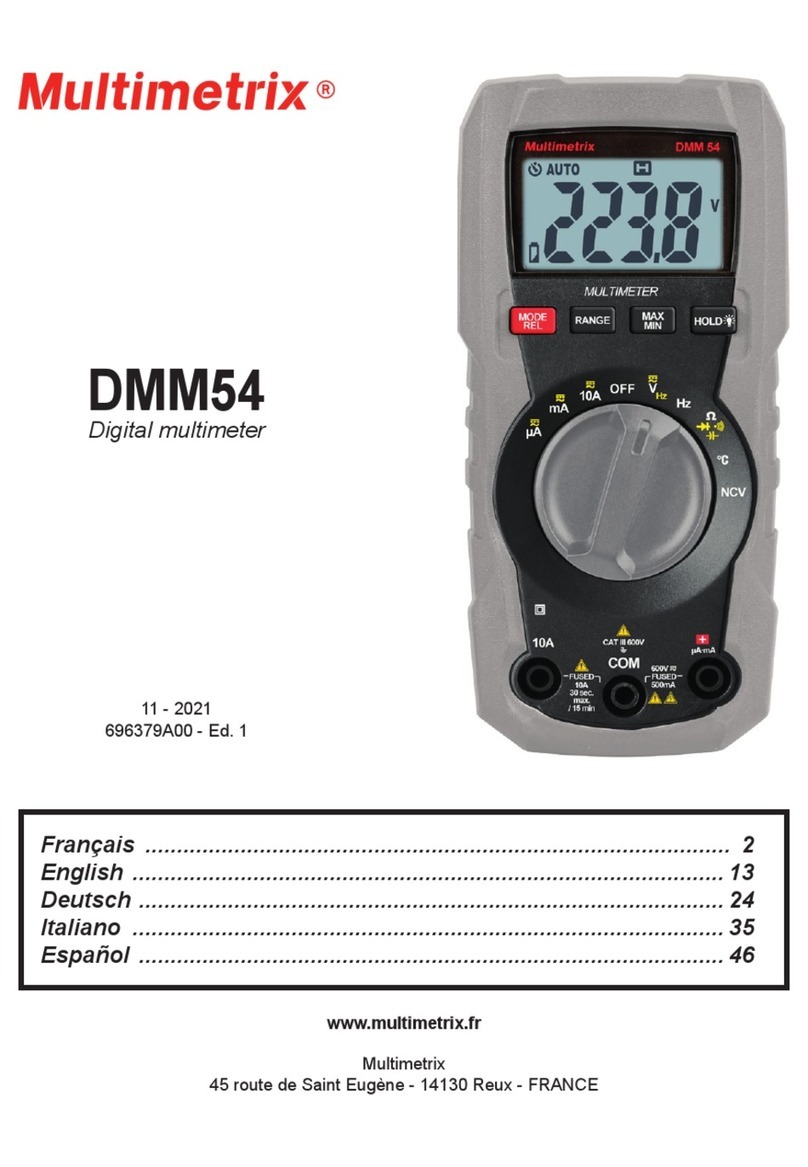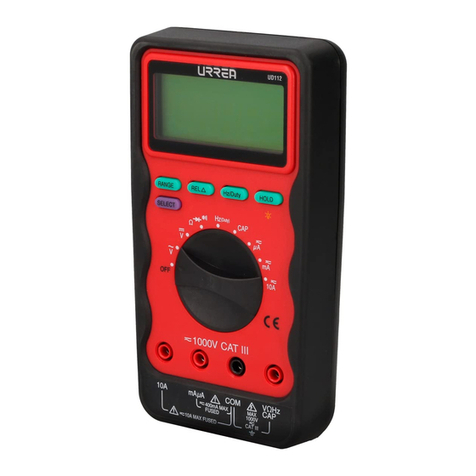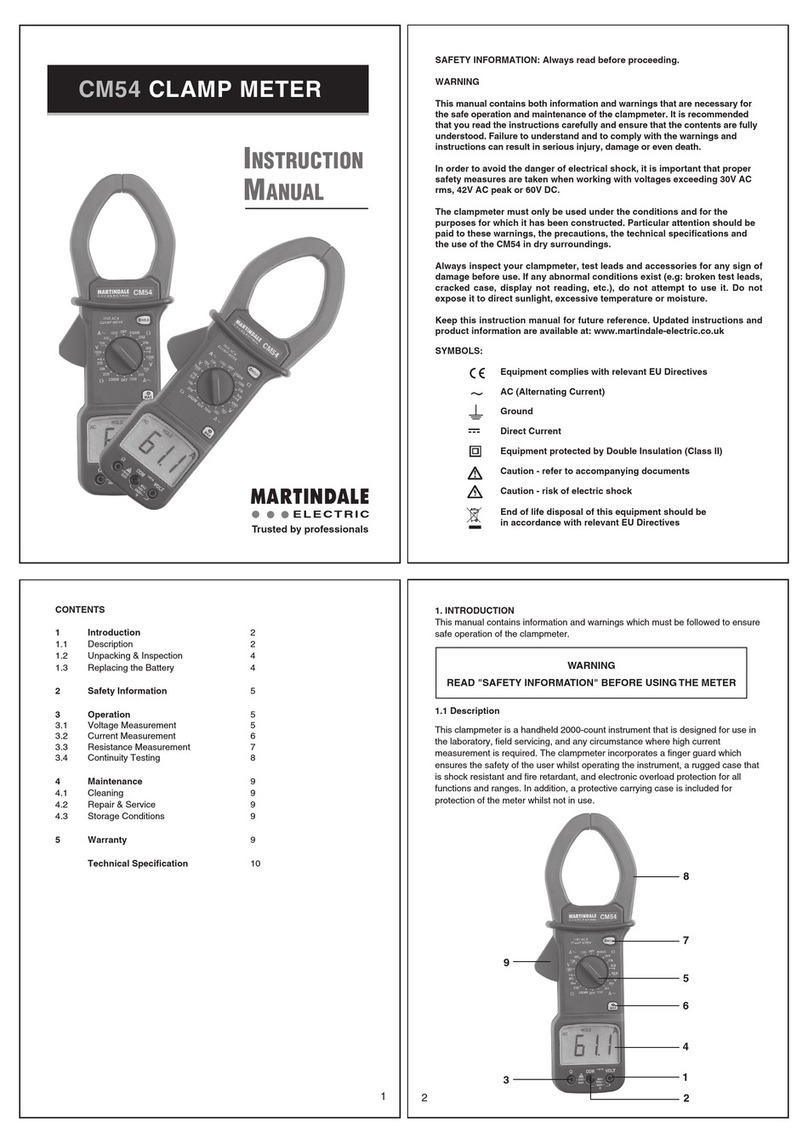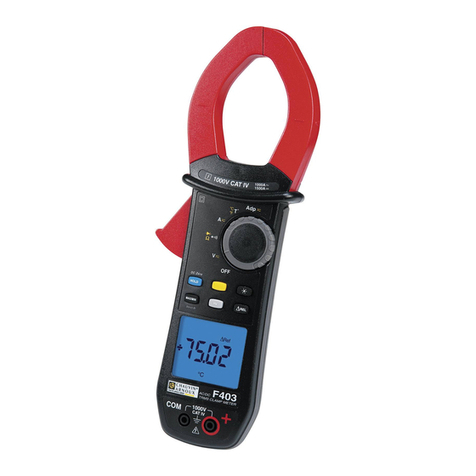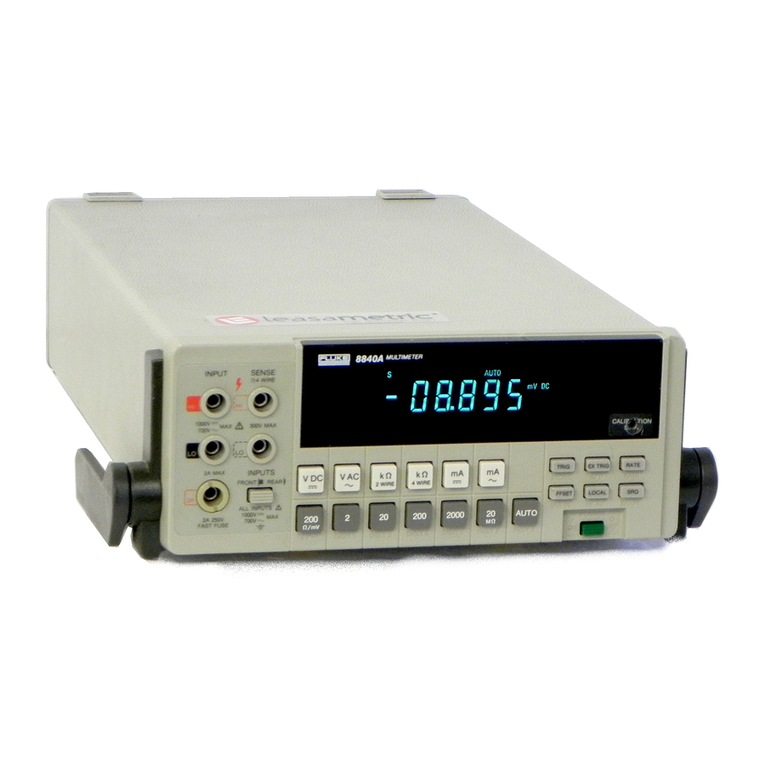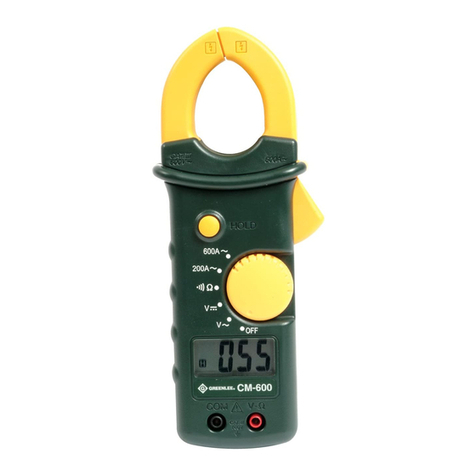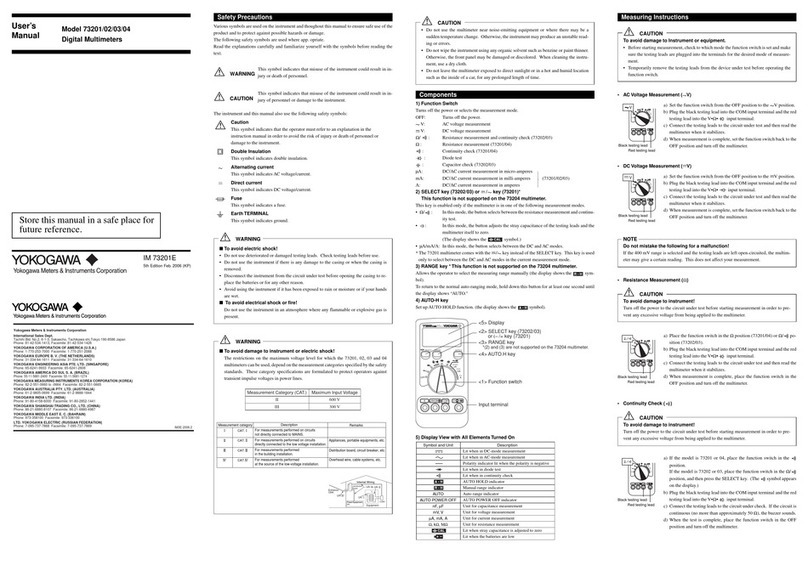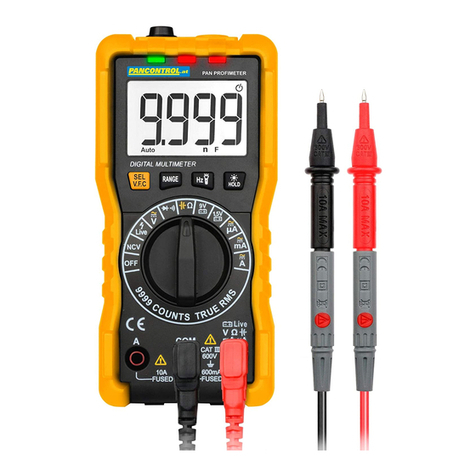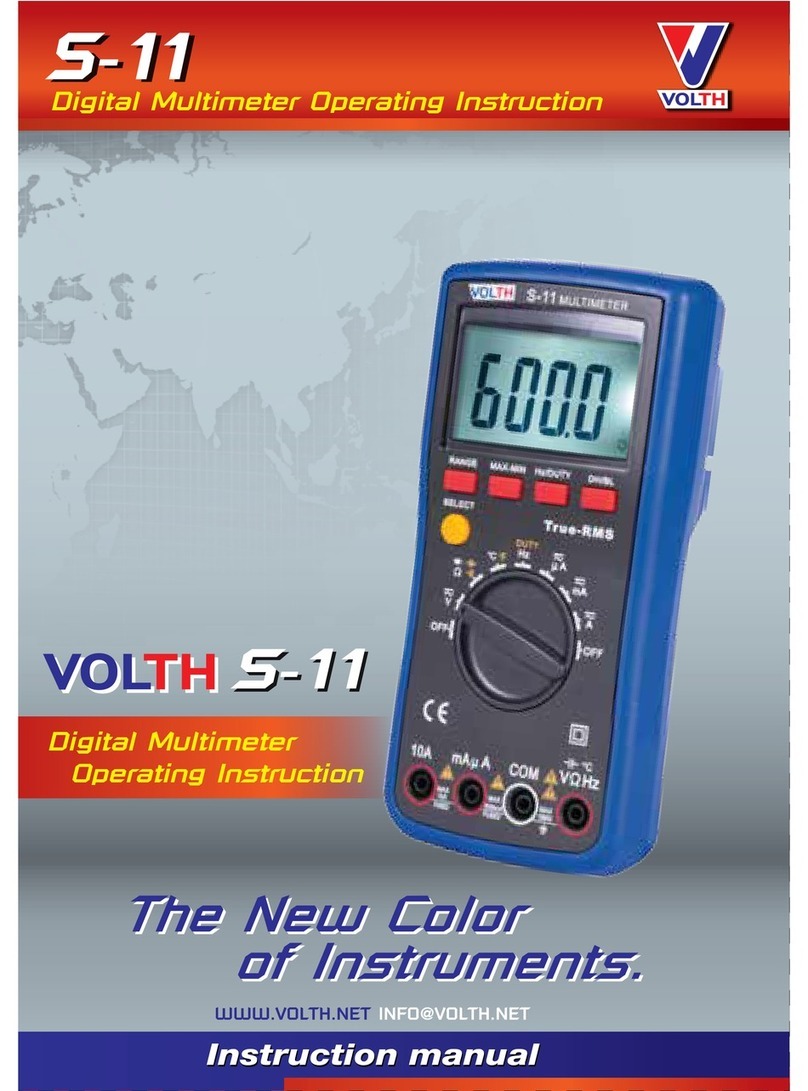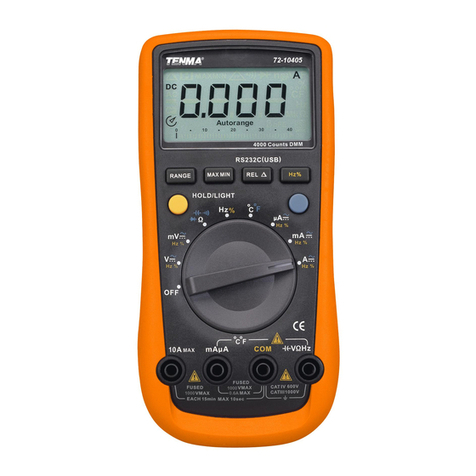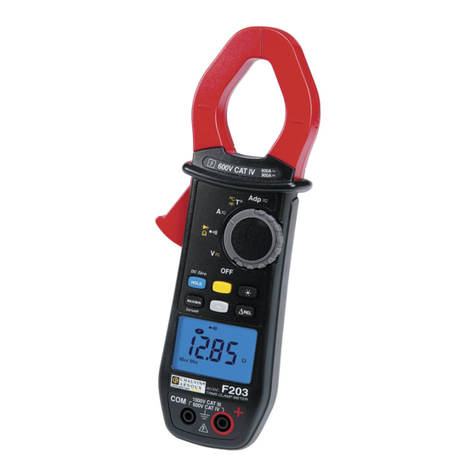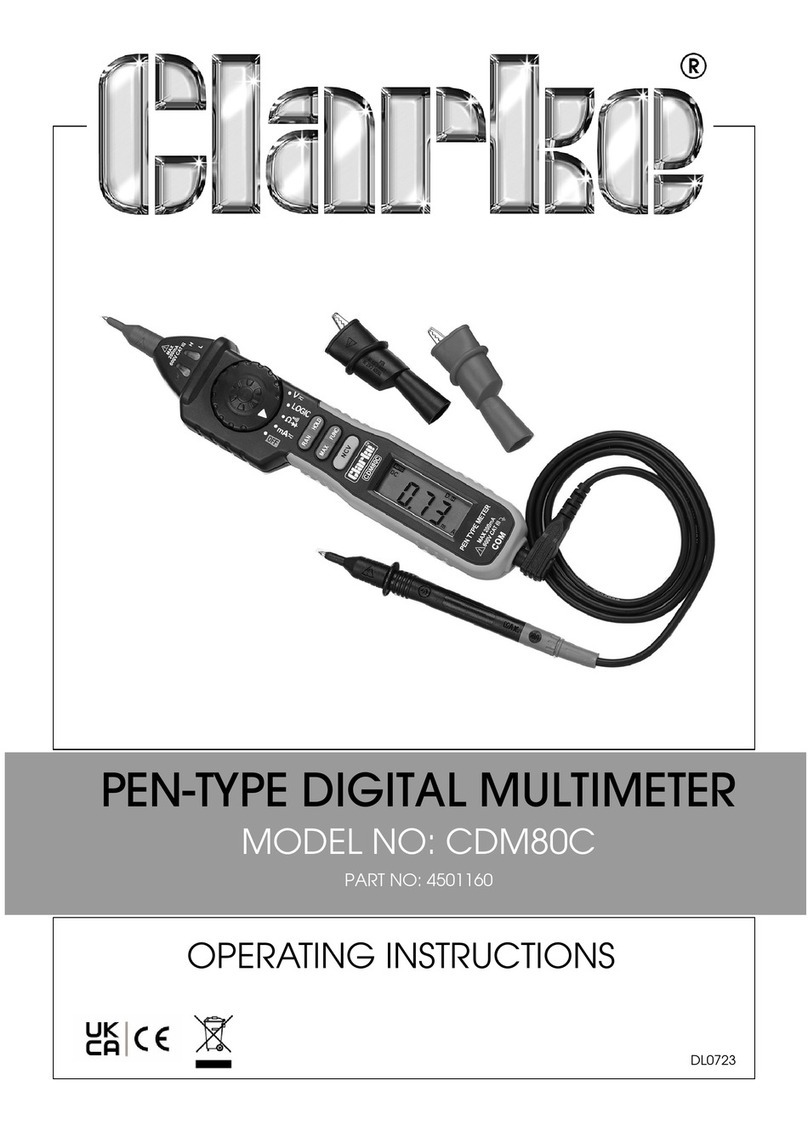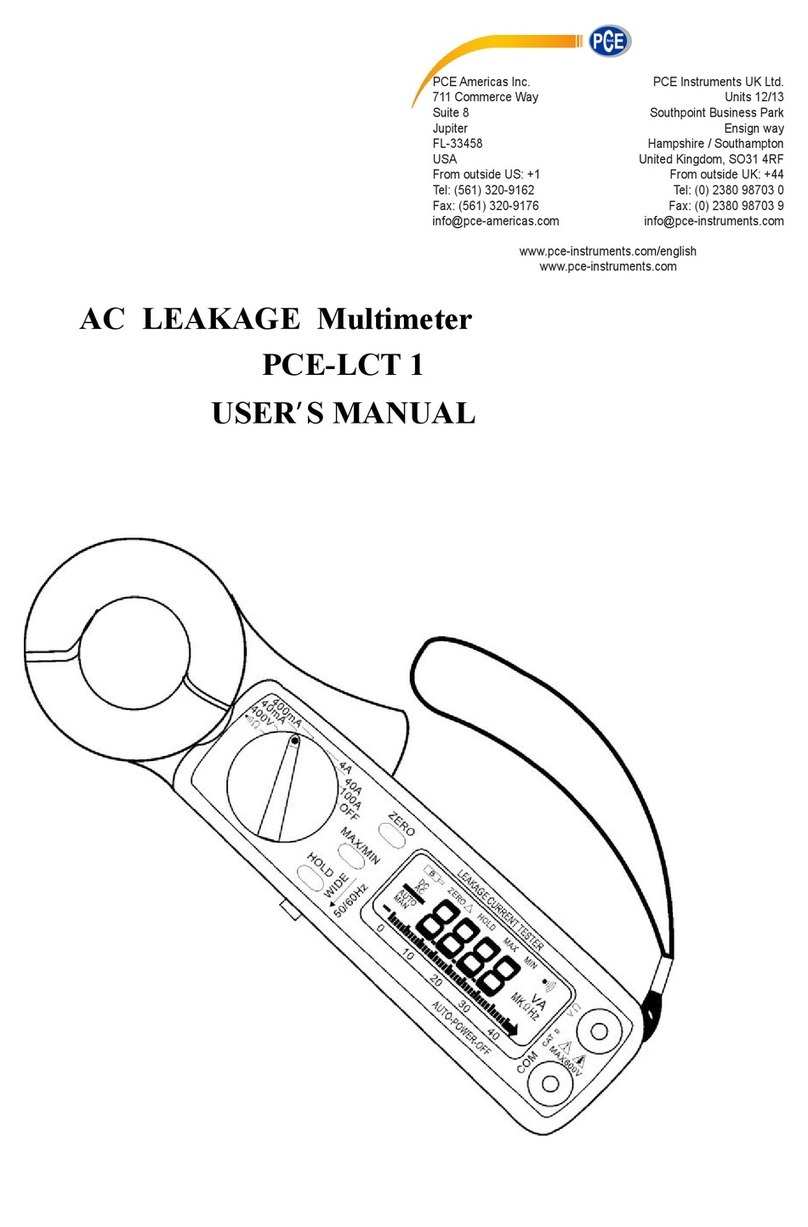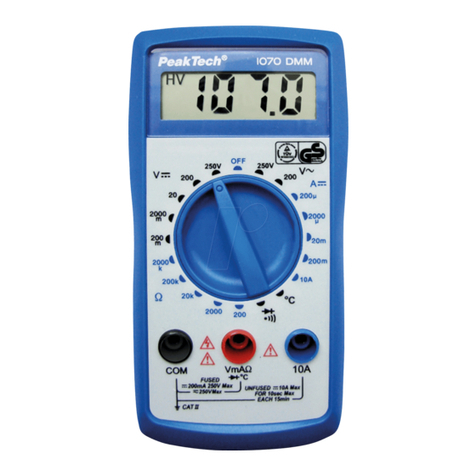Multimetrix DMM 13 User manual

DMM 13
Multimeter
User’s manual
CHAUVIN ARNOUX
190, rue Championnet
75876 PARIS Ce dex 18 - FRANCE
Tel.: +33 1 44 85 44 85-Fax: +33 1 46 2 7 73 89
info@chauvin-arnoux.fr
Expor t: Tel.: +33 1 44 85 44 38-Fax: +33 1 46 27 95 59
export@chauvin-arnoux.fr
You have just acquired a DMM13 multimeter and we thank you for your confidence.
PRECAUTIONS FOR USE
This device is compliant with safety standards IEC61010-1 and 61010-2-033 for voltages up
to 300V in category III (or 600V in category II) at an altitude below 2,000m, indoors, with a
degree of pollution of not more than 2.
These safety instructions are intended to ensure the safety of persons and proper
operation of the device. If the device is used other than as specified in this data sheet, the
protection provided by the device may be impaired.
The operator and/or the responsible authority must carefully read and clearly understand
the various precautions to be taken in use.
If you use this instrument other than as specified, the protection it provides may be
compromised, thereby endangering you.
Do not use the instrument in an explosive atmosphere or in the presence of flammable
gases or fumes.
Do not use the instrument on networks of which the voltage or category exceeds those
mentioned.
Do not exceed the rated maximum voltages between terminals or with respect to earth.
Do not use the instrument if it seems to be damaged, incomplete, or poorly closed.
Before each use, check the condition of the insulation on the leads, housing, and
accessories. Any item of which the insulation is deteriorated (even partially) must be
set aside for repair or scrapping.
Use leads and accessories rated for voltages and categories at least equal to those of
the instrument. If not, an accessory of a lower category reduces the category of the
combined multimeter + accessory to that of the accessory.
Observe the environmental conditions of use.
Do not modify the instrument and do not replace components with "equivalents".
Repairs and adjustments must be done by approved qualified personnel.
Replace the battery as soon as the symbol appears on the display unit.
Disconnect all leads before opening the battery compartment cover.
Use personal protective equipment when conditions require.
Keep your hands away from the unused test probes of the device.
When handling the test probes, crocodile clips, and accessories, keep your fingers
behind the physical guard.
Disconnect the test probes from the measurement circuit before changing
functions.
MEASUREMENT CATEGORIES
CAT II: Circuits directly connected to the low-voltage installation.
Example: power supply to electro-domestic devices and portable tools.
CAT III: Power supply circuits in the installation of the building.
Example: distribution panel, circuit-breakers, machines or fixed industrial devices.
CAT IV: Circuits supplying the low-voltage installation of the building.
Example: power feeders, counters and protection devices.
- 1 -
For best results from your instrument:
read these operating instructions carefully;
comply with the precautions for use.
Meaning of the symbols used:
Risk of danger. The operator agrees to refer to these instructions whenever
this danger symbol appears.
Battery
The CE marking indicates conformity with European directives.
Double insulation or reinforced insulation.
Selective sorting of wastes for the recycling of electrical and electronic
equipment within the European Union. In conformity with directive WEEE
2002/96/EC: this equipment must not be treated as household waste.
DC– Direct current
AC– Alternating current
AC and DC– Alternating and direct current
Earth
Instructions that must be read and understood
1. PRESENTATION
This is an instrument for the measurement of
electrical
quantities that groups the following functions:
AC or DC voltage measurement
Frequency measurement
Resistance measurement, continuity
measurement with buzzer (diode test)
Capacitance measurement
Automatic determination of the quantity to be
measured from the setting of the switch.
Test probe: 1 red (+) and 1 black (-).
- 2 -
1.1 The switch
The switch has three positions. To access the various functions, set the switch to the
corresponding positions. Each active position is confirmed by an audible signal. The
functions are described in the table below.
OFF Stop
V/Hz
AC or DC voltage measurement/Frequency measurement
Automatic detection of the AC or DC voltage to be
measured.
Resistance measurement, continuity measurement with
buzzer, or diode test and capacitance measurement.
Automatic detection of the quantity to be measured.
When switched on, the multimeter is in "SCAN" mode (automatic detection) and analyzes
the input signals to determine what quantity is to be measured.
In this mode, the "RANGE", "HOLD", and "MAX MIN" keys are deactivated.
1.2 The keypad
Here are the functions of the keys of the keypad:
- "SEL" (SELECT) key
The "SEL" key is used to access the functions of the "RANGE", "HOLD", and "MAX MIN"
keys and choose the quantity to be measured manually (stops the "SCAN" mode).
Press the "SEL" key repeatedly to obtain the following functions according to the setting
of the rotary switch:
V
DC voltage/AC voltage
Functions obtained:
Resistance measurement/continuity measurement/diode
test/capacitance measurement.
Functions obtained:
- 3 -

06 - 2014
694242A02 - Ed. 5
DEUTSCHLAND - Chauvin Arnoux GmbH
Straßburger Str. 34 - 77694 Kehl / Rhein
Tel.: (07851) 99 26-0 - Fax: (07851) 99 26-60
ESPAÑA - Chauvin Arnoux Ibérica S.A
C/ Roger de Flor N° 293, Planta 1- 08025 Barcelona
Tel.: 902 20 22 26 - Fax: 934 591 443
ITALIA - Amra SpA
Via Sant’Ambrogio, 23/25 - 20050 Bareggia di Macherio (MI)
Tel.: 039 245 75 45 - Fax: 039 481 561
ÖSTERREICH - Chauvin Arnoux GmbH
Slamastrasse 29 / 2 / 4 - 1230 Wien
Tel.: 01 61 61 961-0 - Fax: 01 61 61 961-61
SCANdINAVIA - CA Mätsystem AB
Box 4501 - SE 18304 TÄBY
Tel.: +46 8 50 52 68 00 - Fax: +46 8 50 52 68 10
SCHWEIZ - Chauvin Arnoux AG
Einsiedlerstraße 535 - 8810 Horgen
Tel.: 044 727 75 55 - Fax: 044 727 75 56
UNITEd KINGdOM - Chauvin Arnoux Ltd
Waldeck House - Waldeck Road - Maidenhead SL6 8BR
Tel.: 01628 788 888 - Fax: 01628 628 099
MIddLE EAST - Chauvin Arnoux Middle East
P.O. BOX 60-154 - 1241 2020 JAL EL dIB (Beirut) – LEBANON
Tel.: (01) 89 04 25 - Fax: (01) 89 04 24
CHINA - Shanghai Pu-Jiang - Enerdis Instruments Co. Ltd
3 F, 3 rd Building - N° 381 Xiang de Road - 200081 S HANGHAI
Tel.: +86 21 65 21 51 96 - Fax: +86 21 65 21 61 07
USA - Chauvin Arnoux Inc - d.b.a AEMC Instruments
200 Foxborough Blvd. - Foxborough - MA 02035
Tel.: (508) 698-2115 - Fax: (508) 698-2118
- "RANGE" key
Your multi meter has a range change function that is normally auto matic but can be made
manual. After the quantity to be measured is chosen manually ("SEL" key), the default
mode is automatic range change: the "AUTO" message is then displayed.
Briefly press the "RANGE" key to change to manual mode: the "AUTO" message is
then replaced by "MANU".
Successive brief presses are used to reach the desired range.
Hold the "RANGE" key down for 2 seconds to return to the automatic range change
mode: the "MANU" message reverts to "AUTO".
"HOLD" key
In the "HOLD" mode, the device freezes the display of the last value measured.
Pressing the "HOLD" key briefly during a measurement freezes the display: the
message is then displayed.
A second brief press on the "HOLD" key is used to return to the normal
measured value display refresh mode: the message disappears from the
display unit.
"MAX MIN" key
The device records the maximum and minimum values of the measurements made. The
automatic range change does not change the range when this mode is entered; if the
maximum values exceed the display range (indicated by the "OL" message), the
appropriate higher range must be chosen manually before reactivating the "MAX MIN"
mo de .
Successive brief presses on the "MAX MIN" key produce, in order, the following actions:
1st press: the device records and displays the maximum value
measured. The "AUTO" message is replaced by "MANU" and the "MAX" message is
displayed.
2nd press: the device records and displays the minimum value measured; the
"MAX" message is replaced by "MIN".
3rd press: the device records the maximum and minimum values measured
simultaneously; it is the value currently measured that is displayed; the "MAX" and
"MIN" messages blink simultaneously on the display unit.
Additional presses serve to display the values recorded one by one by
reproducing the actions of the previous successive presses.
Press the "MAX MIN" key for two seconds to exit from the mode: the "MANU", "MAX",
and "MIN" messages are replaced by "AUTO", indicating that the device once again
changes range automatically.
"Hz" (Hertz) key
When the switch is set to "VHz", a brief press on the "Hz" key displays the frequency of
the voltage being measured.
A 2nd press restores the display of the voltage being measured.
- 4 -
1.3 The display unit
SCAN
Automatic search for the quantity to be measured
AUTO
Automatic range change
MANU
Manual range change
(Data Hold) Freezes the display
Continuity test function
APO
(Auto Power Off) automatic switching off activated
Diode test function
Display of the maximum and minimum values
DC measurement and display
AC measurement and display
Presence of hazardous voltage above 30V
Display of a negative value
Low battery indicator (battery must be replaced)
Hz
(Hertz) unit of frequency
(ohm, kilo-ohm, Megohm) unit of resistance
V
(Volt) unit of voltage
(milliFarad, nanoFarad, microFarad) units of capacitance
The "OL" message (OverLoad) indicates an overshoot of the measurement or display
capacity. A display of dashes indicates waiting for the determination and selection of the
quantity to be measured.
1.4 The leads and test probes
The multimeter is equipped with 2 leads (1 red and 1 black), each terminated by a test
probe of the same colour. The leads and test probes are not detachable (they are
permanently connected) and, whe n not in use, can be stowed in the compartments
provided for them on the right side of the device.
The tips of the test probes (once taken out of their compartments by pressing on them
with a finger), allow voltage, resistance, continuity, diode test, and capacitance
measurements.
The test probes have physical guards that show the operator where the hand grip part
ends, beyond which the fingers must not be placed.
- 5 -
2. USE
2.1 Commissioning
Place the batteries supplied with the device as follows:
1. Using a cross-headed screwdriver, unscrew the screw of the compartment cover on
the back of the housing and open the cover.
2. Place the 2 batteries in their compartment, with the correct polarities.
3. Close the cover and screw it back to the housing.
2.2 Starting up and check of operation
We recommend performing this procedure at the time of commissioning and, if the device
is used only occasionally, each time it is used.
Hold the "HOLD" key down and switch the instrument on by turning t he switch from
"OFF" to "Ω".
Keep the "HOLD" key pressed and check that the various symbols and segments
are correctly displayed (the 1st digit on the left may be a "6" or an "8").
Releasing the "HOLD" key restores the normal display for the function chosen.
If the device is set to the resistance measurement function ("Ω"), check that the
display indicates "A.P.O" (for auto power off), "SCAN" (for automatic search for the
quantity to be measured), dashes "---" (to indicate search in progress).
Withdraw the two leads from their compartment and establish a good contact between
the metallic parts of the two test probes; the value measured and displayed must
change from "---" to "0.0Ω" accompanied by the message " " (the value displayed
may not be exactly zero, but must remain very close to zero).
The instrument is operational when the various states described above have been
checked and are correct. The rotary switch can then be set to the desired function or
to "OFF" to switch the instrument off.
2.3 Deactivating Auto Power Off
In order to extend the life of the batteries, the device switches itself off automatically
approximately 10 minutes after it is switched on if no key or change of function has been
activated.
- 6 -

The device warns that it is about to switch off by emitting 3 series of 2 audible beeps
and, if no action is taken, then emits a long beep and switches itself off.
When the multimeter has switched itself off automatically, it can be reactivated by
any action on a key or on the rotary switch.
Automatic switching off can be deactivated by holding dow n the "Hz", "MAX MIN", or
"R-H" key while switching on.
To eliminate the slight residual drai n of the batte ries in t he s leep mode, it is always
best to switch the device "OFF".
2.4 DC voltage measurement (V )
For optimum safety, measurements of voltages between 300V and 600V must be
made only on category III installations or on circuits of which the possible overvoltage
levels are known to be less than those of category III.
The instrument has 4 measurement ranges: 600mV, 6.0V, 60V, 600V.
The 600mV range can be used only in the manual range change mode, by repeated
presses on the "RANGE" key. The other ranges can be used in either the manual or the
automatic range change mode.
Withdraw the test probes and leads from their compartment.
Switch the instrument on in the "V" setting.
Apply the metallic part of the black test probe on the (assumed) ne gative part of the
circuit to be tested.
Apply the metallic part of the red test probe on the (assumed) positive part of the
circuit to be tested.
Read the measurement result (after stabilization).
Display of the "-" sign in front of the numerical value indicates that the value measured is
negative (the test probes are reversed with respect to the polarity of the voltage)
2.5 AC voltage measurement (V )
For optimum safety, measurements of voltages between 300V and 600V must be
made only on category III installations or on circuits of which the possible overvoltage
levels are known to be less than those of category III.
The instrument has 4 measurement ranges: 600mV, 6,0V, 60V, 600V.
The 600mV range can be used only in the manual range change mode, by repeated
presses on the "RANGE" key. The other ranges can be used in either the manual or the
automatic range change mode.
Withdraw the test probes and leads from their compartment.
Switch the instrument on in the "V" setting.
Apply the metallic part of the black test probe on the part of the circuit to be tested
(assumed) closest to the earth potential.
Apply the metallic part of the red test probe on the part of the circuit to be tested
(assumed) farthest from the earth potential.
In the "SCAN" mode, if the voltage to be measured is greater than 0.5V, the
multimeter automatically determines if an AC or DC measurement must be made.
If necessary, press the "SEL" key briefly to force an AC voltage measurement (display
of the " " symbol instead of " ")
Read the measurement result (after stabilization).
- 7 -
2.6 Frequency measurement (Hz)
For optimum safety, measurements of voltages between 300V and 600V must be
made only on category III installations or on circuits of which the possible overvoltage
levels are known to be less than those of category III.
The instrument has 3 measurement ranges: 600,0Hz, 6,000kHz and 60,00kHz.
Measurement of the frequency of the voltage measured: start the AC voltage
measurement method, then press the "Hz" key (display of the "Hz" symbol instead
of "V").
Read the measurement result after stabilization.
2.7 Resistance measurement (Ω)
Resistance, continuity, diode test, and capacitance measurements must be made
only on circuits completely disconnected from any power supply, and after any capacitors
have been discharged.
The instrument has 6 measurement ranges: 600,0Ω, 6,000kΩ, 60,00kΩ, 600,0kΩ,
6,000 MΩ and 60,00 MΩ. All of the ranges can be used with either automatic or manual
range change.
Withdraw the test probes and leads from their compartment.
Switch the instrument on and set to " ".
Apply the metallic tips of the test probes to the terminals of the resistance or of the
circuit to be tested.
In the "SCAN" mode, the multimeter automatically determines the nature of the
quantity to be measured.
If necessary, press the "SEL" key briefly to change to the desired measurement
mo de .
Read the measurement result (after stabilization).
NB: Touching the elements or circuit during the measurement may lead to erroneous
results. For resistance measurements on nonlinear circuits, it may be necessary to select
the measurement mode and the range to be used manually.
2.8 Continuity measurement (Ω)
Resistance, continuity, diode test, and capacitance measurements must be made
only on circuits completely disconnected from any power supply and after any capacitors
have been discharged.
The instrument indicates continuity by emitting a steady sound when t he resistance
measured is less than 30Ω. The value displayed is the value measured in ohms.
Withdraw the test probes and leads from their compartment.
Switch the instrument on and set to " ".
Apply the metallic tips of the test probes to the terminals of the resistance or of the
circuit to be tested.
In the "SCAN" mode, the multimeter can automatically determine and select the
continuity mode when the resistance measured remains low; otherwise press
the "SEL" key briefly until the continuity symbol " " appears
Read (if necessary) the measurement result (after stabilization).
- 8 -
2.9 Diode measurement (Ω)
Resistance, continuity, diode test, and capacitance measurements must be made
only on circuits completely disconnected from any power supply, and after any capacitors
have been discharged.
The instrument indicates the voltage across the terminals of the semiconducting junction.
Withdraw the test probes and leads from their compartment.
Switch the instrument on and set to " ".
Apply the metallic tips of the test probes to the terminals of the diode or circuit to
be tested.
In the "SCAN" mode, the multimeter can automatically determine and select the
diode test mode when the voltage measured is less than approximately 0.8V,
otherwise, press the "SEL" key briefly until the diode test symbol " " appears.
The test probes must be applied to the terminals of the diode or junction to be tested
according to the following polarities.
1) forward direction (conducting): apply the black probe to the cathode and the red
probe to the anode. Read the measurement result (after stabilization), see figure A
(the threshold voltage of a silicon diode is between 0.5V and 0.7V; it is between 0.2
and 0.3V for a germanium diode. High-voltage diodes, some Zener diodes, and LEDs
cannot be tested by this method).
2) reverse direction (non-conducting): apply the black probe to the anode and the red
probe to the cathode. Read the measurement result (after stabilization), see figure B
(a diode or junction in good condition causes the display of "OL").
With some types of diode, a measured value outside the stated voltage ranges
does not necessarily mean that the diode or junction is defective.
3. CHARACTERISTICS
3.1 General conditions
Quantity of influence
Reference conditions
Temperature 23°C ±5°C
Relative humidity 45% to 75%
Supply voltage 2,8V ±0,3V
Frequency range of the applied signal 45-400Hz
Sine wave pure
Peak factor of the applied AC signal √2
AC magnetic field none
Electric field none
- 9 -
3.2 Characteristics under the conditions of use
Sampling rate: approximately 3 measurements per second
The uncertainties are expressed in ± (x% L + y digit).
3.2.1 DC voltage measurement
Range
Resolution
Measurement uncertainties
Input resistance
600.0mV
0.1mV
1.0%+3 approx. 10 MΩ
6.000V 0.001V
60.00V 0.01V
600.0V
0.1V
3.2.2 AC voltage measurement
Range Resolution
Measurement uncertainties
Input resistance
45~60Hz
60~400Hz
600.0mV 0.1mV 1.5%+5 -
approx. 10 MΩ
6.000V 0.001V
1.5%+5
60.00V 0.01V
600.0V 0.1V
3.2.3 Resistance measurement
Range Resolution Measurement
uncertainties
Voltage
maximum
applicable
600.0Ω0.1Ω
1.0%+5
600V
6.000kΩ 0.001kΩ
60.00kΩ 0.01kΩ
600.0kΩ 0.1kΩ
6.000MΩ 0.001MΩ 2.0%+5
60.00MΩ 0.01MΩ 3.0%+5
- 10 -

3.2.4 Continuity measurement
Range Resolution
Observation No-load voltage
600.0
Ω
0.1ΩThe buzzer is actuated
at values <≈ 30Ωapprox. 0.8V
3.2.5 Diode test
Range Resolution Measurement uncertainties No-load voltage
2.000V 0.001V 1.0%+5 approx. 2.0V
3.2.6 Capacitance measurement
Range
Resolution
Measurement uncertainties
Remarks
6.000nF
0.001nF
2.5%+50
-
60.00nF
0.01nF
2.5%+8
600.0nF
0.1nF
2.5%+5
6.000μF
0.001μF
60.00μF
0.01μF
600.0μF
0.1μF
6.000mF
0.001mF
3.0%+5
60.00mF
0.01mF
4%+5
3.2.7 Frequency measurement
Range Resolution Measurement uncertainties Notes
6.000kHz 0.001kHz 0.1%+3 -
60.00kHz
0.01kHz
Sensitivity
Range
Minimum input signal (sine wave)
10Hz~5.999kHz
6.00kHz~59.99kHz
600mV 60mV -
6.0V
0.3V
3V
60V
2V
6V
600V
20V
60V
- 11 -
3.3 Environmental conditions
Environmental conditions in use in storage
Te mperature 0°C to +50°C
32°F~122°F
-10°C to +60°C
14°F~140°F
Relative humidity (RH) ≤80% without
condensation
≤70% without
condensation
Altitude <2.000m up to 10,000m
3.4 Constructive characteristics
Housing Rigid polycarbonate shell with moulded elastomer covering
Screen LCD display Dimension: L 41 x H 18mm
Dimension H 130 x L 81 x P 24mm
Weight 150g (without battery)
3.5 Power supply
Batteries: 2x1.5V (AAA)
Mean battery life >250 hours
Auto power off delay After approximately 10 minutes without action on
the switch and/or on the keys
3.6 Compliance with international standards
Electric safety
Protection class
Compliant with standards IEC61010-1 and IEC61010-2-033
300V CAT III.
Class 2, double insulation
Electromagnetic
compatibility
Compliant with standard EN61326-1
Level of protection of
the housing Housing: IP40 (according to the standard IEC60529)
- 12 -
4. MAINTENANCE
The instrument has no parts that can be replaced by personnel who are not trained and
approved. Any non-approved repair or other work, or replacement of a part by an
"equivalent", may severely compromise safety.
4.1 Cleaning
Disconnect the unit completely and turn the rotary switch to OFF.
Use a soft cloth, dampened with soapy water. Rinse with a damp cloth and dry rapidly
with a dry cloth or forced air.
Dry perfectly before putting back into use.
4.2 Replacement of the batteries
The symbol indicates that the batteries are spent. When this symbol appears on
the display unit, the batteries must be replaced. The measurements and specifications
are no longer guaranteed.
To replace the batteries, proceed as follows:
1. Disconnect everything connected to the device;
2. Set the switch to OFF;
3. using a cross-headed screwdriver unscrew the screw of the battery compartment
cover on the back of the housing and open the cover;
4. Always replace both batteries;
5. Close the cover and screw it back down.
4.3 Repair
Return the instrument to your distributor for any work to be done, whether under the
warranty or not.
If you have to ship the instrument, it is best to use its original packaging and to state as
clearly as possible, in a note attached to the equipment, the reasons for the transfer.
5. WARRANTY
The equipment is warranted against defects of materials or workmanship, in accordance
with the general terms of sale.
During the warranty period (1 year), the instrument must be repaired only by the
manufacturer, who reserves the right to choose between repairing it or replacing it,
entirely or partially.
- 13 -
If the equipment is sent back to the manufacturer, carriage is paid by the customer.
The warranty does not apply in the following cases:
1. Inappropriate use of the equipment or use with incompatible equipment;
2. Modifications made to the equipment without the explicit permission of the
manufacturer’s technical staff;
3. Work done on the device by a person not approved by the manufacturer;
4. Adaptation to a particular application not anticipated in the definition of the
equipment or not indicated in the user’s manua l;
5. Damage caused by shocks, falls, or floods.
6. DELIVERY CONDITION
The DMM13 multimeter is delivered in a blister pack with:
2 1.5V batteries
a user manual in several languages
- 14 -
Other Multimetrix Multimeter manuals
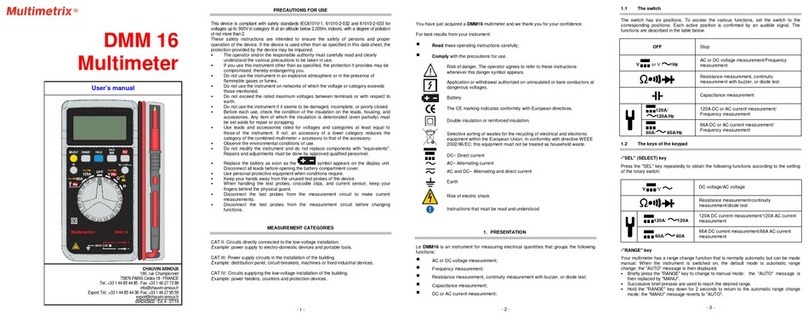
Multimetrix
Multimetrix DMM 16 User manual
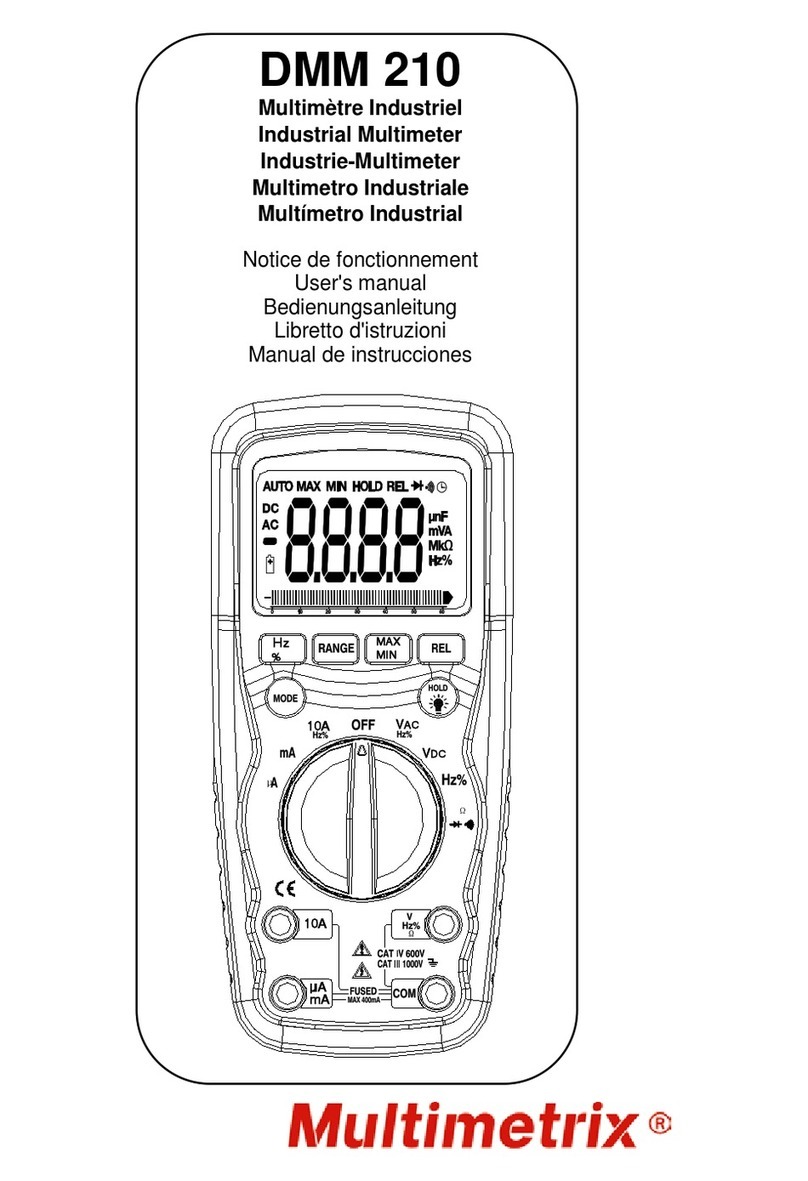
Multimetrix
Multimetrix DMM 210 User manual

Multimetrix
Multimetrix DMM 107 User manual
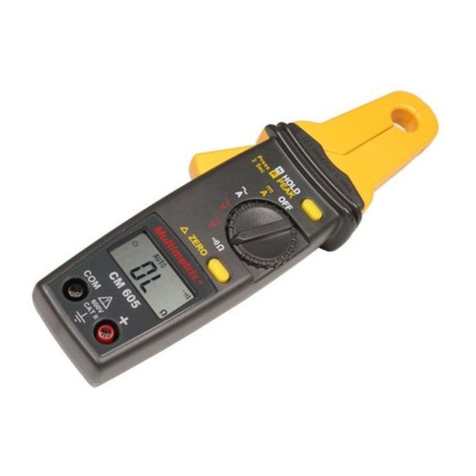
Multimetrix
Multimetrix CM 605 User manual
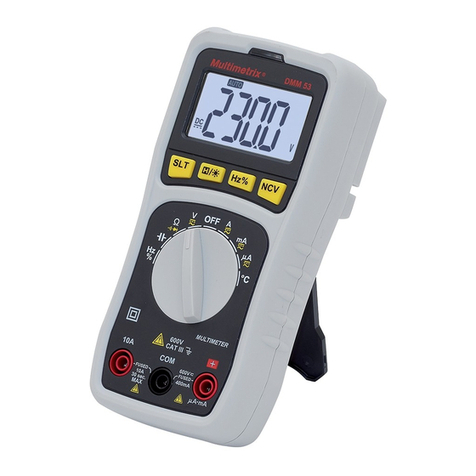
Multimetrix
Multimetrix DMM53 User manual

Multimetrix
Multimetrix DMM 240 User manual
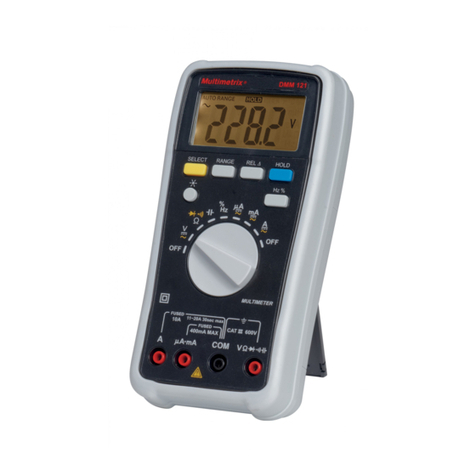
Multimetrix
Multimetrix DMM121 User manual

Multimetrix
Multimetrix CM603 User manual
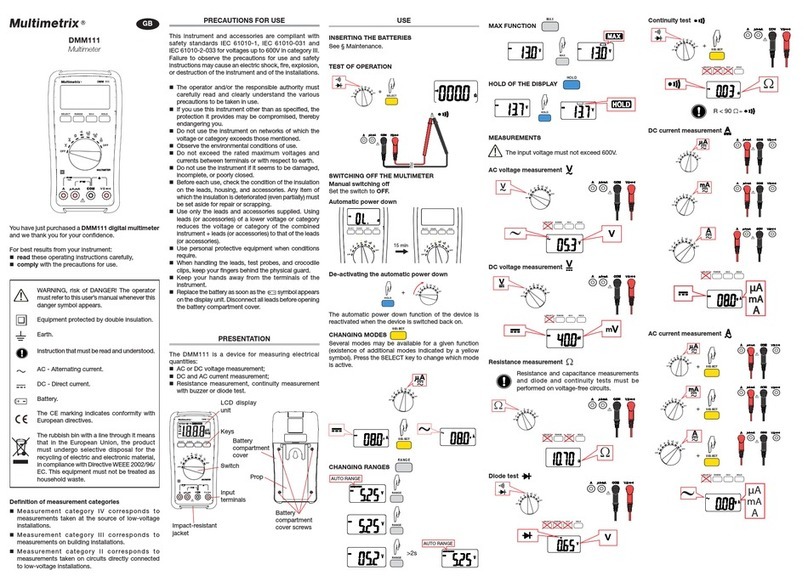
Multimetrix
Multimetrix DMM111 User manual
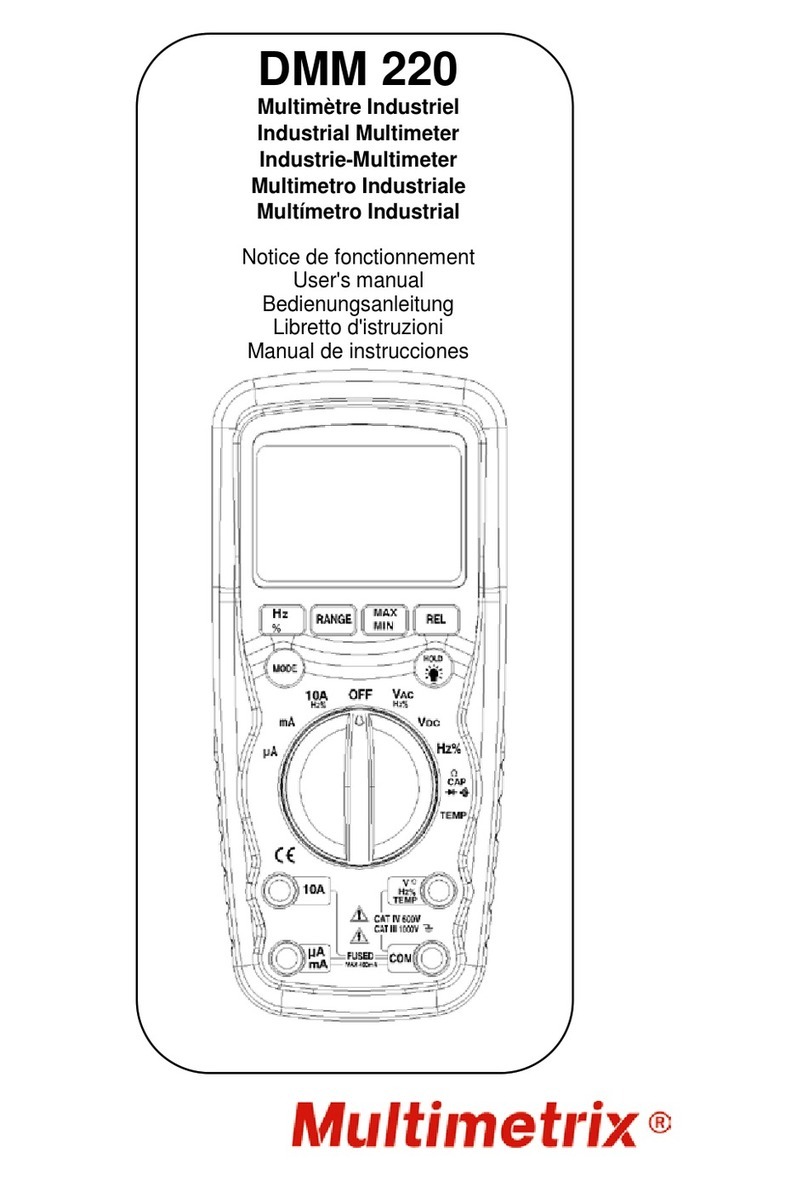
Multimetrix
Multimetrix DMM 220 User manual
